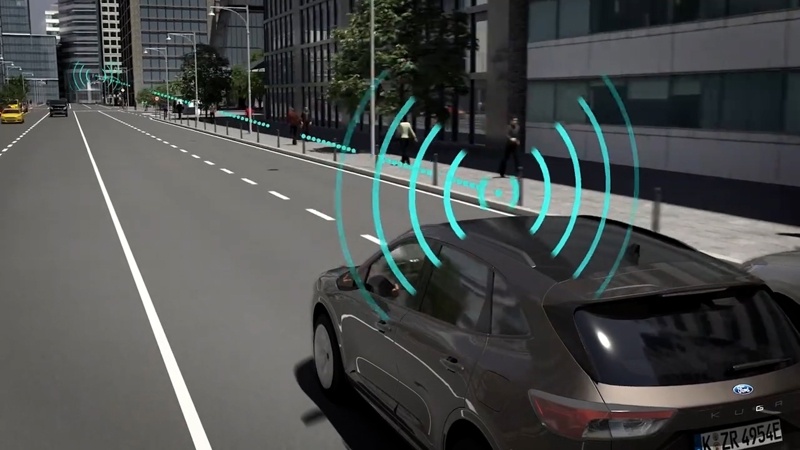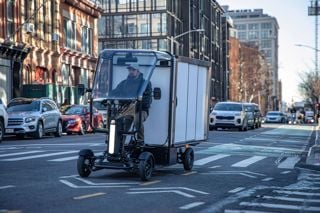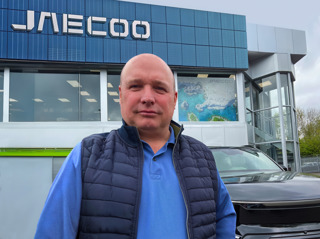
It is widely accepted that human errors are responsible for around 90% of road collisions, with the dawn of self-driving vehicles expected to drastically cut the number of crashes.
However, the day when fully-autonomous cars and vans are widespread on public roads in the UK is still many, many years away.
But there is another technology which AASHTO, an association which represents highway and transportations departments across the United States, believes can reduce or mitigate the impact of up to 80% of collisions and is much closer to breaking through and that is vehicle-to-everything (V2X).
This enables a vehicle to talk with others (vehicle-to-vehicle: V2V), infrastructure (vehicle-to-infrastructure: V2I) and vulnerable road users (vehicle-to-pedestrian: V2P), and it provides drivers with real-time information about what is happening in the world around them.
The technology would allow the information to be displayed in the vehicle cabin for the driver to see, meaning they could be alerted to potential hazards around them which they cannot see.
“You could be in your car behind a bus and unable to see what is happening in front of it,” says Francis McKinney, senior project delivery lead at Zenzic.
“If there was a vehicle braking heavily ahead of that bus, wouldn’t it be good to have advance warning of it to give you more time to react?”
Other safety use cases could be alerting drivers about cyclists in their vehicle’s blindspots or informing them of a collision or lane closure on the road ahead.
“Different places will have different use case needs, so we will probably see different things happen in different parts of the country,” says Andy Chappell, senior programme manager at Commsignia.
“For example, some of the vulnerable road user use cases could be useful in London where there is a lot of micromobility and cyclists, and this could involve alerting lorry drivers about cyclists in their vicinity when they are about to turn left.
“On country roads, it could let drivers know there’s a cyclist around the next blind corner, enabling them to take the appropriate action.”
Safety rating
The technology’s potential to reduce the number of collisions has also been noted by safety organisations such as Euro NCAP, which has mandated that, from 2027, in order for a car to achieve a maximum five-star rating it will need to be fitted with V2X capability.
Chappell says although safety will drive the implementation of V2X, it is not clear which use cases will be introduced first as there are “probably 100 or so” different ones.
Some of these are either already in operation or been trialled in other countries.
In the US, for example, V2X is being used in Atlanta to give priority at junctions to express buses that are behind schedule.
It requires only about three changes of red traffic lights to get a bus back on schedule, says Chappell.
Detroit has introduced V2X on some intersections to give priority to snowploughs to allow them to clear the roads more quickly.
In Germany (see panel), Ford has trialled connected traffic light technology that could automatically go green to offer clearer routes for bluelight services.
Wider use of using V2X on traffic lights could reduce congestion by optimising traffic flow, improve journey time reliability and reduce emissions caused by vehicles stopping and starting repeatedly.
Emergency services could also use V2X to respond to certain road incidents, such as someone driving the wrong way on a motorway, or for breakdown recovery organisations to assist vulnerable road users.
These use cases – and others – mean V2X will have direct benefits for fleet operators, says Chappell.
“With delivery drivers, for example, it could be used to get information to them about speed limits, parking information and restrictions, and making their routes more efficient, but also making sure they obey the local rules,” he adds.
“At the moment I believe fleets kind of accept parking fines as part of the cost of doing business, and V2X could help them avoid these.”
Road infrastructure
Chappell says the widespread adoption of V2X could also lead to changes in road infrastructure.
This could include the reduction in the number of overhead gantries required to display information on temporary speed limits and traffic news as the information would be transmitted directly into vehicles.
Road design could also change. “If we knew there was a particular spot on a road that was subject to heavy braking, then we could inform the road operators and they could maybe look at the road design to prevent accidents, rather than having to react to them,” says Chappell.
“There would be all sort of data created by the system which could be used to do road surveys before new designs are put in place on the road.
“You could actually see how traffic flows without having to dig up roads to install sensors which has been done in the past.”
Although the technology is in use on public roads in America and some other parts of the world, it is still in its testing and trial phase in the UK.
“From a technology point of view, the UK is pretty well advanced,” says Chappell.
“We’ve got some great testing facilities now, both off-road and on-road with the CAM UK Testbeds, but in terms of taking V2X to the next level and deploying it at scale and reaping the benefits, we are perhaps a little bit behind.
“If we look at China, we know there are 19 different models of car out there with a V2X label, and in North America, Ford has got models out there and announced more are coming.
“But we do have the capability to pick it up and come back.”
However, there are a number of challenges which need to be solved before V2X becomes a reality in the UK.
These include the high level of complexity and the many stakeholders involved in the ecosystem, as well as the need for collaboration and co-ordination between road operators, mobile network operators and vehicle manufacturers to enable services to move towards deployment.
Also, no nationwide ecosystem is currently being developed while different manufacturers and regions use different standards, which make it risky for organisations to invest in specific solutions.
Paradigm shift
“It’s a paradigm shift for the industry,” says McKinney. “Traditionally, a vehicle manufacturer manufactures a car, tests it in isolation and then sells it into the market.
“The road infrastructure guys do a similar thing with their systems and, effectively, it’s the driver that integrates the two together.
“With V2X it’s different because the OEM and infrastructure suppliers need to ensure their products will talk to each other, but it’s been so difficult to get a unifying architecture that will allow all of these services to operate together.”
Commsignia led a Zenzic-coordinated project at the turn of the year in partnership with CAM Testbed UK partners including Vodafone and Nokia to address some of these issues.
It aimed to deliver a reliable, trusted and secure service which is scalable for end-to-end trials and testing of initial V2X services.
“We’ve tried to develop an architecture to show people that you could have a common architecture and use services on that,” says McKinney.
“This allows people to come and test their services in a controlled environment.”
The first live implementation of V2X in the UK took place in the West Midlands last year and saw Vodafone work with Transport for West Midlands and Nokia.
While the ideal V2X scenario is that all vehicles will be fitted with the technology, this should not be needed for it to have a significant impact.
Mobile phone use
“A lot of good can be done through the use of existing cellular networks and existing mobile phone handsets,” says Bob Banks, technology development manager at Vodafone.
“With all of the legacy vehicles out there, chances are every single one will have a handset in it as somebody will take their phone into that.
“You can use updates and apps in vehicles with Android Auto or Apple CarPlay smartphone integration to generate quite a large capability.
“You could also include handsets carried by pedestrians, cyclists and horse riders to create a system that can really start to take off.”
Vodafone has built on the West Midlands trial with the launch last month of its Safer Transport for Europe Platform, which allows public authorities to deliver safety and traffic information directly to smartphone mapping apps and in-vehicle navigation systems.
Chappell adds: “Something which isn’t obvious is that you don’t necessarily need all cars to have V2X to have a magnified benefit.
“If you’re following a car that is V2X-enabled and it has more time to react to an incident, then you also have more time to react even if you don’t have V2X.
“I think that you’ll start to see benefits when penetration rates are relatively low, and then as the use cases build out and V2X use increases, you’ll start to see more benefit.”
V2X kicks in when bluelight services need the green light
Ford has trialled connected V2X technology that could ensure traffic lights automatically go green to offer clearer routes for ambulances, fire engines and police vehicles.
The project saw a V2X-enabled Kuga SUV communicate with eight consecutive traffic lights in Aachen, Germany, and two stretches with three consecutive traffic lights just outside the city.
While testing an emergency response situation, the vehicle signalled to the traffic lights to turn the light green.
Once the vehicle had passed through the junction, the lights returned to standard operation.
For testing daily driving situations, the vehicle received the timing information as the traffic lights turned from red to green and green to red.
Ford’s adaptive cruise control then adjusted the vehicle’s speed to help ensure a higher proportion of traffic encountered a green light.
When the traffic light was red, the vehicle’s speed was reduced well ahead of the junction to time the vehicle’s approach to arrive at the light the moment it turned green, for example from 30mph to 20mph.
For vehicles encountering a red light, the technology could still help to minimise harsh braking and the time spent at a standstill.
The vehicle received the traffic light information well ahead of the junction and slowed down earlier, helping to reduce congestion.
Ford engineers tested the system as part of the Corridor for New Mobility Aachen-Düsseldorf (Accord) project, funded by the
German Federal Ministry for Digital and Transport. The project ran from January 2020 to March this year.





















Login to comment
Comments
No comments have been made yet.